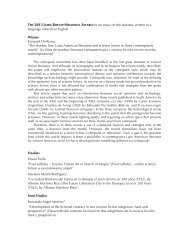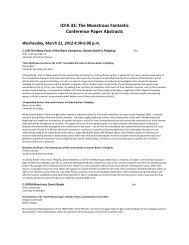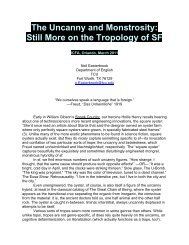140. (CYA) <strong>The</strong> <strong>Monstrous</strong> Self MapleChair: Janice HawesSouth Carolina State University<strong>The</strong> Inflicted “Self” in Robin McKinley's Deerskin: Implanted Memories, Fragmented Bodies, and Re-envisioned IdentitiesKendra HolmesUniversity of FloridaIn both narratives and literary theory, trauma has had many denotations, representations and connotations. Freud explains trauma as theoccurrence of a situation or circumstance too vast for our consciousness to process. Barthes relates trauma to the “punctum”-- a sensory arrestthat disallows any rational understanding of perceived circumstances. Jacques Lacan uses trauma to describe the meaning of his term, the“Real,” which is a space that can neither be tamed nor named, a space that thrives on chaos and disrupts our everyday lives. <strong>The</strong>orist such asFredric Jameson and Nicholas Abraham, have suggested that spaces of the fantastical, in relation to trauma, are constructed in order to recivilizethe “inflicted” protagonist and re-institutionalize the bildungsroman.Using Robin McKinley's Deerskin (1993), I will argue that the spaceof the “fantastical” acts as a continuous space of re-constructed memories, trauma, and a compilation of identities; resulting in a change inidentity and forgotten history. I will argue that the creation of the fantastical space or entity is the rupture in one’s identity. As highlightedthrough McKinley's novel, I believe that “fantastical” fragments the body by conflating the “self” and the “other”. Moreover, “implanted”memories become a process of sustaining trauma, while the magical creates traumas. I will conduct a Lacanian reading of the text, applyingLacan's Three Orders, <strong>The</strong> Symbolic, Imaginary, and Real to McKinley's novel. Thus, applying Lacan's structures to the growth and developmentof Lissar (the protagonist) in her journey to becoming a civilized, (un)fragmented adult. In my paper, the “symbolic” will be mapped onto thespace of memory and the fantastical, the “real” onto trauma, and the imaginary onto Lissar's psychological and biological development fromchild to adult.<strong>The</strong> Mirror Self and the Dream Self: Recognizing Disparity between Psychic and Performed IdentitiesNaToya FaughnderUniversity of FloridaPerhaps there is no greater recognized symbol of the outcast than that of the monster who is most often presented as that which is to befeared; it is the Other, the abject, that which brings discordance to order. In Looking Glasses and Neverlands: Lacan, Desire, and theSubjectivity in Children’s Literature, Karen Coats notes that “[abjection] is the process of expulsion that enables the subject to set up clearboundaries and establish a stable identity.” (140). Like the abjection of the monstrous figure in society, the abjection of the monstrous self is ameans of establishing a stable identity construction, of establishing an identity performance recognizable as within society’s boundaries ofacceptance. This is a process present in adolescence, presented in the struggle to leave behind childhood and achieve maturity and adulthood.In Catharine Fisher’s Corbenic, a contemporary YA Arthurian novel based upon the Perceval Grail Quest, the process of maturation andabjection is explored through the complicated intersections of trauma, memory, and the mythic past. Fisher’s protagonist must confront themonstrousness of his traumatic past and his deepest fears for himself (including the knowledge that he may have inherited his mother’sschizophrenia) in order to truly come to terms with who he is and the adult he is becoming. This essay explores the roles of trauma,melancholia, and memory in identity construction, asserting that sometimes what one wishes to expel is that very quality that makes one whos/he is. Fisher’s novel, I will argue, represents that it is only through a confrontation with the self—with personal traumas, fears, and biases—that real psychological growth can occur. In this paper, I draw from children’s literature scholars such and Karen Coats (above), RobertaSeelinger Trites, and Eric Tribunella, but I also closely examine the Arthurian literature from which Fisher draws her source material and muchof the pertinent scholarship concerning those texts.Becoming the Dark Lord: Colonial-Cultural Rupture and Constructing Antihistorical Identity in Kage Barker’s <strong>The</strong> House of the StagShaun DukeUniversity of FloridaOne of the unique methods used by the colonial system to reproduce its culture is by controlling history. Dipesh Chakrabarty notes that byattempting—and largely succeeding—to make European historical model—linear, “fact”-based history—the “only” way by which culture can berelayed, colonialists managed to suppress indigenous culture. But such processes also created an acute sense of exile amongpostcolonial/subaltern peoples—what Yanick Lahens calls “internal exile.” Since the colonial model sought to degrade or devalue non-European culture (i.e., reconfigure the indigenous as other), the feeling of exile had repercussions for identity formation. <strong>The</strong>se processes formthe basis of Kage Baker’s <strong>The</strong> House of the Stag, a young adult maturation text. Gard, the protagonist, is doubly-exiled, forced out into a worldof empires where he must construct a new identity for himself in a sea of cultural impositions. What lies at the heart of Baker’s text is a drivefor a subaltern figure to consume a historical narrative and to demand an identity that operates on their terms. Using postcolonial theory, thus,becomes a productive avenue for considering how subaltern figures such as Gard manipulate historical narratives to form new identities. Forthis paper, I will use theorists like Chakrabarty, Lahens, and Spivak to argue that Baker enacts a form of antihistorical narrative that eagerlyseeks to recreate a connection to a lost history through the fabrication of an identity based on reshaping history/mythology and acceptinginternal monstrosity or otherness. <strong>The</strong> construction of Gard’s identity, thus, arises from a colonial-cultural rupture that demands anantihistorical response, one which at once reconciles the processes of exile which make subalternity possible and makes manipulating historicalnarratives a constitutive element of resistance.
141. (FTV) <strong>Monstrous</strong> Masculinity CypressChair: Andrea HairstonSmith CollegeWill Smith: Heroism and Sexuality in SF FilmSharon DeGrawMichigan State UniversityHistorically, sf film has followed the lead of sf literature in relying on an Anglo, masculine triangle of protagonist, audience, and director/author.In the 1970s, however, sf films began including secondary black characters. Black male protagonists have become more common over the pastdecade. A single actor, Will Smith, has made great in-roads in the Anglo male tradition of sf film. Over the past 15 years, through a series offilms, Smith has become a leading sf actor in the United States. As Adilifu Nama asserts, “it is Will Smith who reinvigorated the status ofblackness in SF cinema.” Despite Smith’s tremendous success, however, he still remains hindered from a full range of human portrayal, in thatromance and/or sexuality are elided in his films. “If a movie is to appeal to a white [male] audience, the black actor must be neutered,” arguesStephen Barnes. Romance is not a staple of sf film, but there exists a discrepancy between the sexuality demonstrated by white male leads andblack male leads. Similarly, Smith displays greater sexuality in his non-sf films. Several techniques are utilized to circumvent black malesexuality. Comedy, a sidekick role, and being in a pre-existing relationship are general film techniques, while aliens, technology, sexism, andapocalyptic/sacrifice are specific to sf. In Smith’s early sf career, comedy and the sidekick role dominate films like Men in Black and Wild WildWest. I, Robot offered Smith’s first serious, lead role in a sf drama, but he remained a sexual object and the nascent romance between DelSpooner and Susan Calvin was safely repressed. I Am Legend solidified Smith’s lead status, as he replaced the iconic Charlton Heston as RobertNeville. However, Heston’s inter-racial romance in the 1971 version is completely cut. It is only in Smith’s latest sf film, Hancock that someromance and sexuality are finally incorporated. While this budding romance too is quickly truncated by a pre-existing relationship and Smith’scomedic role returns in full force, the movie offers hope for the future. Testing the racial acceptance of sf viewers, Hancock suggests thatSmith’s tremendous likability will finally overcome lingering racial prejudice against the expression of black male sexuality.Testosterone Overdose: Grendel as <strong>Monstrous</strong> Masculinity in Beowulf FilmsA. Keith KellyGeorge Gwinnett CollegeOver the past half dozen years the Beowulf story enjoyed a flash of popularity among filmmakers. Robert Zemeckis’s animated version wasreleased with much spectacle and little acclaim in 2007, while 2005 witnessed the screening of “Beowulf and Grendel,” shot in Iceland andstarring Gerard Butler. While these two films were quite different in their depictions of the Anglo-Saxon poem and its plot, there was a markedsimilarity in one particular way Grendel was presented particularly vis a vis Hrothgar and Beowulf himself. Both monsters, and in fact bothfilms, displayed a certifiable overdose of testosterone—and not simply in the hack-n-slash way one might expect. Ranging from the overtlyFreudian presentation of the twisted and hideous Grendel (who in effect serves as a walking phallus), and a seductive Angelina Jolie as hismother in Zemeckis’s production, to the rather sympathy-inspiring Grendel in “Beowulf and Grendel,” monstrosity in both films is directlylinked to masculinity. Furthermore, one might argue that masculinity gone wrong is in fact the source of monstrosity in both adaptations, andthe motivations for conflict in the tale. In this paper I propose to look not so much at the success or failure of the screen adaptations of thisgreat poem, but at the portrayal of monstrosity as twisted masculinity in each.From Final Girl to Initial Beast: Becoming the Male Monster in Halloween 4, Haute Tension, and Other Modern HorrorMike MarraIndependent ScholarIn her “Final Girl” theory, film scholar Carol Clover explores the connection between the antagonist and protagonist in slasher films, usually amale and a female, respectively. She has illustrated this connection in various papers and publications, most notably in her book, Men, Womenand Chain Saws: Gender in the Modern Horror Film. However, there seems to be a very thin line between “becoming the final girl” and“becoming a mindless killer”. This analysis will explore how far many of these “final girls” go in their quest for revenge and whether or not it iswarranted. Are these outbursts of violence justified or have they become no better than the evil that originally stalked them? In this paper, Iplan to analyze various texts (films, televisions programs, video games, etc.) that contain these thematic elements and draw connectionsbetween the characters, the circumstances, and the final girl theory. <strong>The</strong> method for this paper is textual analysis. With this method I willinterpret the various texts at my disposal; in this case this includes the Halloween series of films, Haute Tension, and other applicable texts. Byanalyzing these texts through the lens of the final girl theory and other relevant theories, conclusions will be made. This paper is relevant for anumber of reasons. First and foremost, this study has never been conducted before. This is fresh research that will enrich the pool ofknowledge concerning the aforementioned texts. Also, this analysis will further flesh out Clover’s original theory and expand upon it for evenmore research in the future.
- Page 4 and 5:
5. (F) Wondrous Bodies of the Gende
- Page 6 and 7:
Fantastic Suicide: Reading the Unca
- Page 8:
Viral Posthumanism: Boundaries and
- Page 11 and 12:
The Concept of Soul Divisibility in
- Page 13 and 14:
Thursday, March 22, 2012 10:30 a.m.
- Page 15 and 16:
21. (CYA) Terrifying Futures: Post-
- Page 17 and 18:
23. (FTV/H) Now I’m Feelin’ Zom
- Page 19 and 20:
Fight Club: Amalgam of the Horrific
- Page 21 and 22:
Taking the Monsters out of the Clos
- Page 23 and 24:
Kaspar J. SaxenaIndependent Scholar
- Page 25 and 26:
44. (CYA) The Monstrosity of Teenag
- Page 27 and 28:
46. (FTV/SF) Monstrous Spin-offs: T
- Page 29 and 30:
49. (F) Aspects of Miéville Captiv
- Page 31 and 32:
53. (SF) War and Crisis in 1940s an
- Page 33 and 34:
Abuse of Power: An Evolutionary Res
- Page 35 and 36: Disappearing Natives: The Colonized
- Page 37 and 38: 60. (H/IF) Ancient and Medieval Mon
- Page 39 and 40: 62. (F) The Works of Tolkien Captiv
- Page 41 and 42: 67. (SF) Imperial and Postcolonial
- Page 43 and 44: Beheading the Gorgon: Beautifying C
- Page 45 and 46: 71. (VPA) Monstrous Music MagnoliaC
- Page 47 and 48: 73. (F/IF) Portraying New Worlds Ca
- Page 49 and 50: Friday, March 23, 2012 2:45-3:45 pm
- Page 51 and 52: 81. (FTV) Those Damn Dirty Apes! Cy
- Page 53 and 54: Friday, March 23, 2012 4:00-5:30 pm
- Page 55 and 56: 92. (F) Leaving the Demonized Other
- Page 57 and 58: 94. (FTV/CYA) Monstrosity and Devia
- Page 59 and 60: of cannibalism, ghostly seduction i
- Page 61 and 62: Saturday March 24, 2012 8:30-10:00
- Page 63 and 64: 104. (CYA) Classic Monsters, Reinte
- Page 65 and 66: 107. (VPA) Monstrous Gaming Bodies
- Page 67 and 68: who challenge the order that the Br
- Page 69 and 70: Reading Between the Times: A Critic
- Page 71 and 72: 117. (FTV) Monsters and Superheroes
- Page 73 and 74: 119. (IF/H/PCS) International Mash-
- Page 75 and 76: Focusing on Stoker's Dracula as one
- Page 77 and 78: Florida Atlantic UniversitySheri S.
- Page 79 and 80: Simmons CollegeIn the spate of rece
- Page 81 and 82: Independent ScholarKing’s story
- Page 83 and 84: modernity opens up for every indivi
- Page 85: Saturday March 24, 2012 4:00-5:30 p
- Page 89 and 90: ultimately make peace with her mons
- Page 91 and 92: where the almost-human sentient zom





